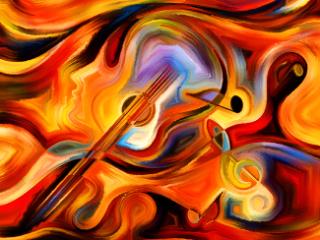The seemingly super-human mental phenomenon known as synesthesia was the topic of discussion this past weekend when scientists, artists, and philosophers of the American Synesthesia Association convened at the University of Miami (UM) to discuss the color of language, the architecture of music, and how the brain puts it all together. The Association’s 11th annual conference was organized by UM’s College of Arts & Sciences Professor of Philosophy Berit Brogaard – an eminent researcher in the field.
Synesthesia is a psychological condition involving the intertwining of normally separate sensory and cognitive pathways. Synesthetes – or people who have synesthesia – may experience the sensation of color when they smell various odors, visualize numerical algorithms as complex shapes or see a rainbow of colors while listening to a concerto. These unique experiences make the phenomenon a valuable topic of research for brain scientists and philosophers, as well as a boon to artists. In some cases, synesthesia contributes to a person’s extraordinary talents. For example, presenter Greg Jarvis, a musician and leader of the orchestral rock group The Flowers of Hell, is a timbre-to-shape synesthete.
“I see the architecture of music,” said Jarvis. It is an ability that he says contributed to his love of grand, sweeping productions, such as Phil Spector’s “Wall of Sound” and Shoegaze music. “What is my ability useful for? The greatest asset of my synesthesia is in music production. I’m working with 140 tracks all at once, and since I can see all the tracks, I can work with more tracks than people who can only hear the tracks,” Jarvis added.
 |
How some brains produce synesthesia and how synesthetic brains differ from those of non-synesthetic brains were questions addressed by keynote speaker Anina Rich, professor and Co-Director of the Perception in Action Research Centre at Macquarie University, Australia, and Dr. Laura Speed, researcher at the Center for Language Studies at Radboud University, Netherlands.
Dr. Rich’s talk, Integrating information and the human brain: insights from synaesthesia, presented findings from cognitive science, which tied synesthesia to attention and semantic processing.
“Attention is a big player in mental integration. Is it necessary for synesthetic binding?” she asked. Her research indicated that the answer is yes, and “this tells us important things about what level synesthesia occurs at,” Rich added. Further study implicated semantic processing in the production of grapheme-color synesthesia. For example, synesthetes who experience the letter “a” as red will not have a synesthetic experience until after the letter has been recognized as an “a.”
Dr. Speed’s talk, Olfactory language and cognition in odour-colour synaesthesia, focused on the experiences and capabilities of synesthetes who associate colors with certain smells.
“Synesthesia involving smell is interesting because, in the West, smell tends to be neglected compared to the other senses. We don’t talk about smells very often. We are bad at naming and remembering smells,” she said. However, this relative neglect of smell experience is not universal. For example, Thai culture places a greater emphasis on smell than Western cultures and consequently most Thais perform well on smell recognition tests.
As it turns out, people with odor synesthesia also do better than average on smell recognition tests because synesthetes experience an associated color when they smell an odor and they have additional information to use in odor recognition tasks. Dr. Speed also recalled some oddities experienced by odor-color synesthetes: One woman felt that her brain was scrambled by the smell of scented washing powder, and another synesthete told of how a woman’s strong perfume left her face looking red all day.
The seemingly impossible nature of synesthesia, coupled with its inherently subjective character, contributed to the historical skepticism synesthetes faced when they gave voice to their ability.
“For years everyone thought synesthetes were making it up,” said artist and researcher Caitlin Gianniny. “At another time I might have been murdered for being a witch.”
Gianniny argued that the experiences of the synesthetic community could be a basis for social solidarity. Synesthetes and minorities share common ground when it comes to the skepticism they face – skepticism synesthetes face when they report their synthetic experiences and skepticism minorities face when they report the racism they are subjected to. “I feel strongly that my experience of synesthesia provides me empathy for groups that have been marginalized in other ways,” Gianniny added.
Synesthesia has long been an underappreciated and misunderstood phenomenon, although public awareness of synesthesia is on the rise due to references made in today’s popular media, such as HBO’s hit television series True Detective and the satirical website The Onion. For more information about the American Synesthesia Association, visit http://www.synesthesia.info/.
October 07, 2015

